




|

Historical Background
The close of the Civil War released America's
energies to the westward movement. Thousands of emigrants and settlers
pushed into the Indian domain with scant regard for the sanctity of
hunting grounds or treaty agreements. Railroads supplanted the trails.
The Union Pacific and Central Pacific, joined in 1869, were succeeded to
the north and south by other transcontinental railroads, and a network
of feeder lines reached into many remote corners of the West. Miners
spread up and down the mountain chains of Colorado, Montana, Idaho,
Nevada, and Arizona. Steamers, sailing up the Missouri River, carried
passengers and freight to Fort Benton, Mont., for the land journey to
the gold mines of western Montana. Stockmen moved onto the grasslands.
Dirt farmers, attracted by the liberal provisions of the Homestead Act
of 1862, followed. Towns and cities sprang up everywhere. The once huge
herds of buffalo dwindled to the brink of extinction, a process hastened
by professional hunters interested only in the hides. Other game
diminished similarly. Forts multiplied, and the soldiers came back in
numbers unprecedented before the war. In a matter of two decades, 1865
to 1885, the Indian was progressively denied the two things essential to
his traditional way of life—land and game. Often he fought back,
and this period of history featured the last—and most
intense—of the wars between the United States and its aboriginal
peoples.
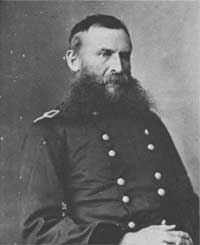 |
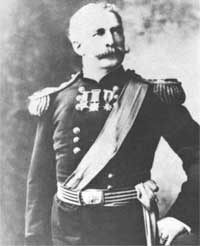 |
| Gen. George Crook. (Library of Congress) |
Gen. Nelson A. Miles. (National Park Service) |
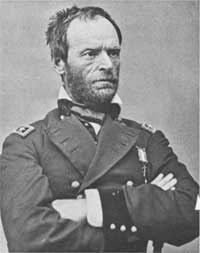 |
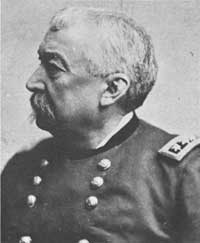 |
| Gen. William T. Sherman. (National Archives) |
Gen. Philip H. Sheridan. (National Archives) |
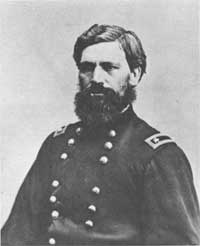 |
 |
| Gen. Oliver O. Howard. (Library of Congress) |
Gen. William S. Harney. (National Archives) |
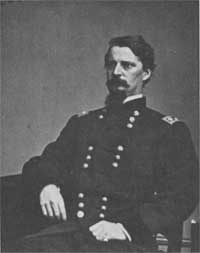 |
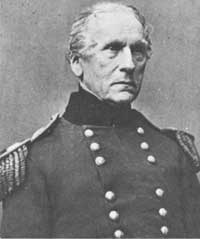 |
| Gen. Winfield S. Hancock. (Library of Congress) |
Gen. John E. Wool. (National Archives) |
Nearly continuous hostilities swept the Great Plains
for more than a decade after the Civil War as the flow of travelers, the
advance of the railroads, and the spread of settlement ate into the
traditional ranges of the Plains tribes. Red Cloud led the Sioux in
opposing the Bozeman Trail, a new emigrant road that cut through their
Powder River hunting domain to the Montana goldfields. The Army
strengthened Fort Reno and erected Forts Phil Kearny and C. F. Smith
along the trail but could not provide security. In December 1866 the
Sioux wiped out an 80-man force from Fort Phil Kearny under Capt.
William J. Fetterman. They tried to triumph again the following August
but in the Wagon Box and Hayfield Fights were beaten back. When the
Union Pacific Railroad reached far enough west to provide another route
to Montana, in the Fort Laramie Treaty (1868) the Government reluctantly
yielded to the Sioux and withdrew from the Bozeman Trail. To the south,
in Kansas, Gen. Winfield S. Hancock led an abortive expedition against
the Cheyennes and Arapahos in 1867 and, instead of pacifying, aroused a
people who had not yet forgotten Sand Creek. Kiowas and Comanches
continued to terrorize the Texas frontier.
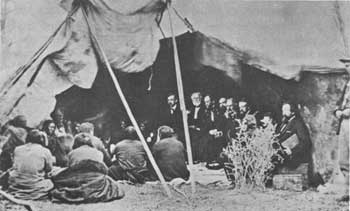 |
| Peace commissioners meeting at
Fort Laramie, Wyo., with Sioux chiefs. The Treaty of Fort Laramie (1868)
brought temporary peace on the northern Plains—until miners invaded
the Black Hills in 1874-75. (National Archives) |
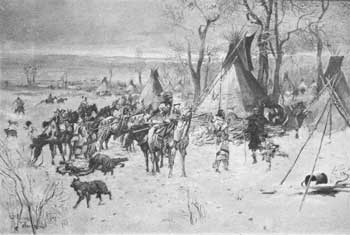 |
| Charles M. Russell's "Indian
Hunters Return" portrays winter life among the Indians. Recognizing
their immobility and vulnerability at that time of the year, Gen. Philip
H. Sheridan launched a hard-hitting winter campaign in 1868-69.
(Montana Historical Society) |
Despite the Medicine Lodge Treaties of 1867, which
were de signed to bring peace to the southern Plains, war broke out once
more in August 1868. Gen. Philip H. Sheridan organized a winter
campaign, in which columns converged on Indian Territory from three
directions. One, under Lt. Col. George A. Custer, struck the Cheyenne
camp of Black Kettle—the same chief who had suffered so grievously
at Sand Creek 4 years earlier. At the Battle of the Washita, November
27, 1868, Custer decimated the band. Black Kettle fell in the first
charge. On Christmas Day another of the commands, under Maj. Andrew W.
Evans, attacked a Comanche camp at Soldier Spring, on the north fork of
the Red River. Custer, Evans, and Maj. Eugene A. Carr, leader of the
third column, demonstrated that the Army could operate during the winter
months, when the Indian was most vulnerable. Most of the tribes yielded
and gathered at newly established agencies in Indian Territory. The
Battle of Summit Springs, Colo., the following July brought the last
holdouts to terms.
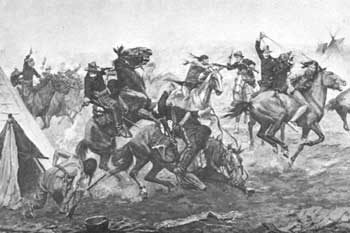 |
| In the Battle of the Washita,
Okla., and in other instances the Army surprised the Indians by
attacking their sleeping villages at dawn. Such an attack is portrayed
in Charles Schreyvogel's "Attack at Dawn." (Gilcrease
Institute of American History and Art) |
http://www.cr.nps.gov/history/online_books/soldier-brave/intro6.htm
Last Updated: 19-Aug-2005
|


















